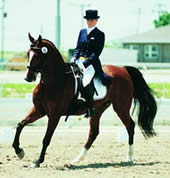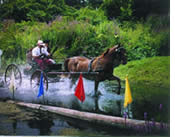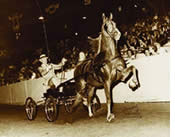|
Return to Breed Profiles Main Page
 The
American Saddlebred - Peacock of the Show Ring The
American Saddlebred - Peacock of the Show Ring
By Rhonda Hart Poe
Nowhere does the label "made in America" fit more perfectly.
America's own breed exemplifies both her heritage and her indomitable
Spirit.
The history of the American Saddlebred reads like that of its namesake
nation. It was born on foreign soils, immigrated to these shores,
melted into the culture, then spread across the colonies, through
the Deep South and westward over seemingly endless mountains and
valleys towards Manifest Destiny.
British colonists sailing to the New World brought select riding
horses. Among these were Scottish Galloways, Irish Hobby horses
and other naturally smooth-gaited horses - collectively referred
to as "palfreys" - the preferred riding mounts there through
the 17th century.
These hardy, little, easy-gaited imports formed the basis of the
legendary Narraganset Pacer, named for the Narraganset Bay of Rhode
Island, the aristocratic center of colonial horse breeding. Averaging
only 14.1 hands, and not particularly handsome, the Narragansets
were popular for their gaits, toughness, even temperaments and sure-footedness.
They became the most sought after horses in the colonies, until
good roads shifted demand to larger, swifter carriage horses. Exportation
and outcrossing further contributed to their disappearance. Huge
numbers were exported to the Caribbean and Canada. Beginning in
1706 English Thoroughbreds were imported to the colonies and the
Narragansets were crossed to improve their size and quality.
The result was a new type of horse. Already established by the American
Revolution this "American Horse" was good sized, well
built and naturally gaited. In a letter to the Continental Congress
in 1776, an American diplomat in France requested one as a gift
for Marie Antoinette.
...an American diplomat in France requested one as a gift for
Marie Antoinette.
Cherished for their smooth gaits and endurance, American Horses
were favored war mounts throughout the early struggles of the fledgling
United States. In the Revolutionary War, settlers rode to illustrious
victory over British troops at the battle of King's Mountain, South
Carolina. In the War of 1812, Kentucky cavalry fought British and
Indian forces from Michigan to Illinois. By the Mexican American
War (1846) the horses that carried American volunteers from Kentucky
and Missouri to war in Mexico were known as American Saddlebreds.
And in the Civil War (1861-1865), countless cavalrymen, from North
and South, rode into battle astride American Saddlers, including
Generals Lee, Grant, Sherman and Jackson. Grant's surrender terms
allowed the Confederates to keep their horses. Two weeks later,
six white American Saddlers pulled President Lincoln's funeral carriage.
Kentucky and Missouri were hotbeds of serious breeding, competing
to produce the best horses. Two families of horses, the Denmarks
and the Chiefs, dominated the bloodlines. The Denmarks, trace to
GAINES' DENMARK, by DENMARK - who, foaled in 1839, was destined
to become the foundation sire of the breed. The Chiefs, through
HARRISON CHIEF, go back to the Thoroughbred, MESSENGER, also the
foundation sire of the Standardbred. Breeders formed the National
Saddle Horse Breeders Association on April 7, 1891- the first horse
breed association in the nation. (In 1899 the name was changed to
the American Saddle-Horse Breeders Association and to the American
Saddlebred Horse Association in 1980.)
 As
early as the 1810's horse shows drew terrific interest as public
entertainment. The first major national show took place in 1856
in St. Louis, the largest city in the "west". Horses were
first required to be shown at the trot - in addition to saddle gaits
- in 1888. State rivalries between Missouri and Kentucky were intense,
culminating in the late 1880's, between two mares, MISS REX of Missouri,
and LOU CHIEF, of Kentucky. In 1893, the black stallion, REX MCDONALD,
took the St. Louis show circuit by storm. He became a national hero
and was bested in the ring only three times in his career, once
by MISS REX. As
early as the 1810's horse shows drew terrific interest as public
entertainment. The first major national show took place in 1856
in St. Louis, the largest city in the "west". Horses were
first required to be shown at the trot - in addition to saddle gaits
- in 1888. State rivalries between Missouri and Kentucky were intense,
culminating in the late 1880's, between two mares, MISS REX of Missouri,
and LOU CHIEF, of Kentucky. In 1893, the black stallion, REX MCDONALD,
took the St. Louis show circuit by storm. He became a national hero
and was bested in the ring only three times in his career, once
by MISS REX.
Many stars of the show ring garnered public adoration. One bonafide
phenomenon was the Five-Gaited Champ, BOURBON KING, foaled in 1900.
He lived to the age of 30 and is still renowned as the preeminent
sire of the Chief line. Another was trainer, Tom Bass, one of the
most famous horsemen in U.S. history. Born a slave in Missouri,
his talents dissolved racial barriers, winning him international
acclaim and respect. He socialized with President Theodore Roosevelt,
Will Rogers, P.T. Barnum and others of high society.
Five-Gaited competitions were exhilarating. CH BELLE LE ROSE, SWEETHEART
ON PARADE, and CH KING'S GENIUS finished in that order in a famous
Championship match at the Kentucky State Fair in 1933. In 1948,
WING COMMANDER won his first Five-Gaited World Grand Championship,
a title he defended for the five years. CH MY-MY held the title
for six years, from 1963 through 1968. In the 1980's, CHIMPERATOR
claimed the title four times as he battled CH SKYWATCH, winner of
eleven different WGC titles, in perhaps the most famous rivalry
in horse show history.
 Other
American Saddlebred celebrities include the flashy CH THE LEMON
DROP KID who ruled Fine Harness ring throughout the 1950's, winning
four World's Grand Champion titles in a row by 1959 and becoming
the only horse to make the cover of Sports Illustrated magazine.
The 1990's saw a multitude of American Saddlebreds dominating a
variety of events, from ARTISITIC REFLECTION'S win in advanced singles
driving at the USET Festival of Champions to WING TEMPO'S unprecedented
winning streak - and 20,000 miles - in NATRC competitive trail riding.
American Saddlebreds have also found their way to the silver screen
in 'Gone with the Wind', as John Wayne's trusty 'Beau' in 'True
Grit', and with William Shatner's use of his own I PREFER MONTANA
in a Star Trek movie, as well as as his Rose Parade Grand Marshall
mount. But then, American Saddlebreds have long been parade favorites. Other
American Saddlebred celebrities include the flashy CH THE LEMON
DROP KID who ruled Fine Harness ring throughout the 1950's, winning
four World's Grand Champion titles in a row by 1959 and becoming
the only horse to make the cover of Sports Illustrated magazine.
The 1990's saw a multitude of American Saddlebreds dominating a
variety of events, from ARTISITIC REFLECTION'S win in advanced singles
driving at the USET Festival of Champions to WING TEMPO'S unprecedented
winning streak - and 20,000 miles - in NATRC competitive trail riding.
American Saddlebreds have also found their way to the silver screen
in 'Gone with the Wind', as John Wayne's trusty 'Beau' in 'True
Grit', and with William Shatner's use of his own I PREFER MONTANA
in a Star Trek movie, as well as as his Rose Parade Grand Marshall
mount. But then, American Saddlebreds have long been parade favorites.
Today's American Saddlebred retains the classic good looks, substance,
strength, versatility - and gait - that made his forebears the horse
of a nation. He is elegant with upright carriage, a high-set, "swan"
neck (accentuated by a long flowing mane on Five-Gaited horses),
good bone, strong, clean legs set squarely beneath him, a deep,
sloping shoulder, sturdy, fairly level back and croup crowned by
a high-set, long flowing tail. In some, much of the whites of the
eye, or sclera, shows, making them look wild-eyed. But what catches
the observer's eye is his presence - what the old-timers called
"dash".
...what catches the observer's eye is his presence - what the
old-timers called "dash".
 Chestnuts
are common, but American Saddlebreds come in all colors and patterns,
except Appaloosa. Palominos and pintos are popular. All are typically
"thin skinned" with fine hair. Height averages from 15
to 16.2 hands, weight around 1,000 to 1,200 pounds. Smooth, four-beat
saddle gaits were critical in the development of the breed and early
horses had to gait for registration. There are now two saddle gaits,
both of which are evenly timed, four-beat gaits. The slow gait,
while intensely collected, can hit speeds of 16 m.p.h., and the
rack, essentially the same gait, is a speed demon's dream, often
topping 25 m.p.h. However, correct form and execution are not to
be sacrificed for speed. High action in the knees and hocks is a
signature of the American Saddlebred show horse. Chestnuts
are common, but American Saddlebreds come in all colors and patterns,
except Appaloosa. Palominos and pintos are popular. All are typically
"thin skinned" with fine hair. Height averages from 15
to 16.2 hands, weight around 1,000 to 1,200 pounds. Smooth, four-beat
saddle gaits were critical in the development of the breed and early
horses had to gait for registration. There are now two saddle gaits,
both of which are evenly timed, four-beat gaits. The slow gait,
while intensely collected, can hit speeds of 16 m.p.h., and the
rack, essentially the same gait, is a speed demon's dream, often
topping 25 m.p.h. However, correct form and execution are not to
be sacrificed for speed. High action in the knees and hocks is a
signature of the American Saddlebred show horse.
There are several bloodlines which produce five gaited horses, i.e.
ANACACHO SHAMROCK, ANACACHO DENMARK (both sons of Edna May's King)
and STONEWALL KING, but the three gaited and fine harness horses
(which don't rack) come primarily from "GENIUS BOURBON KING,"
cites breed historian and editor of the American Saddlebred magazine,
Lynn Weatherman.
For more information contact the American Saddlebred Horse Association,
4093 Iron Works Parkway, Lexington, KY 40511. Phone (859) 259-2742
or visit these websites: www.asha.net,
www.american-saddlebred.com,
www.saddlehorsereport.com
or www.saddlebrednetwork.com
|

